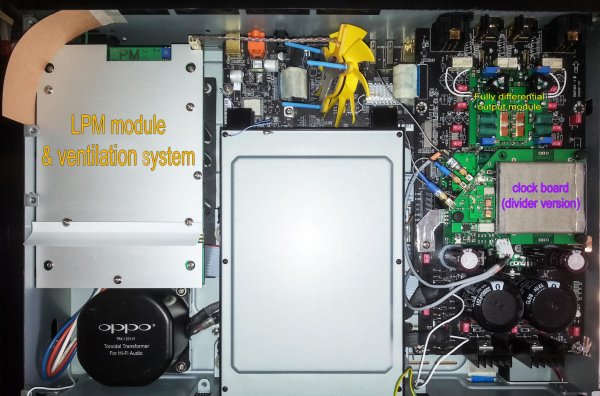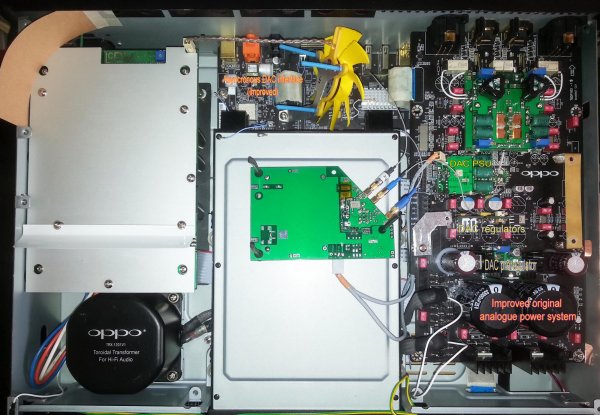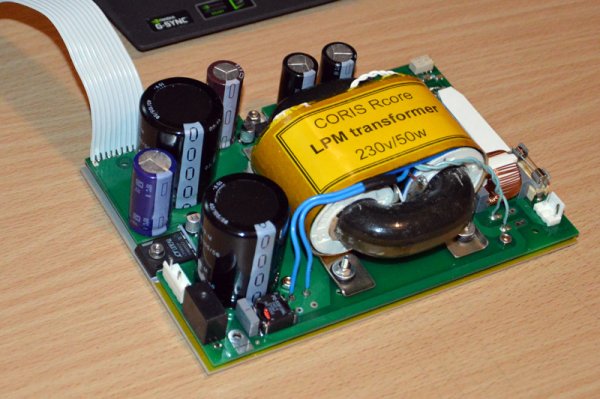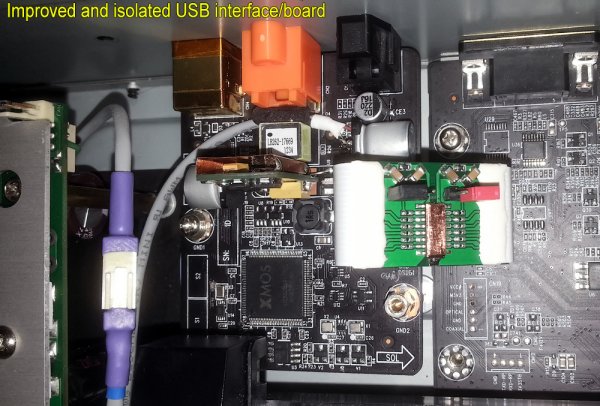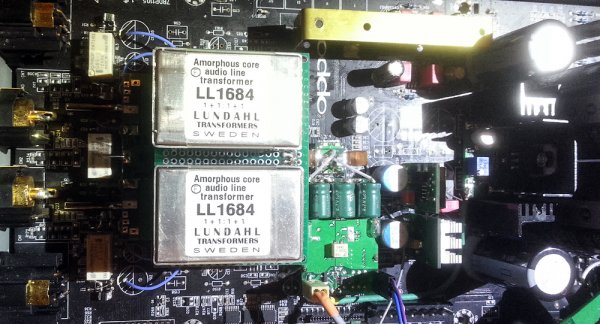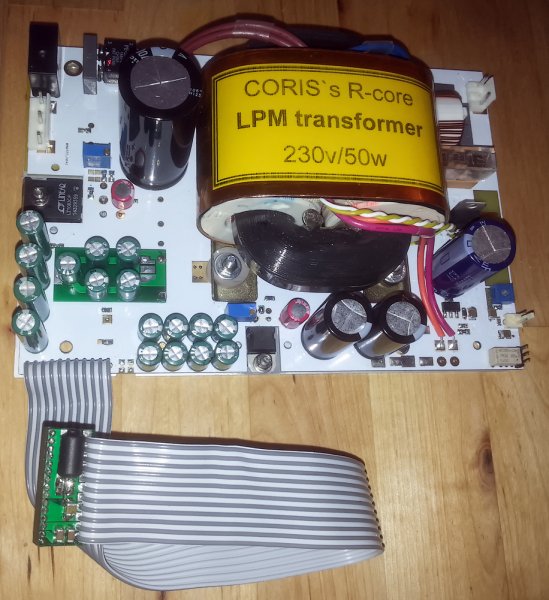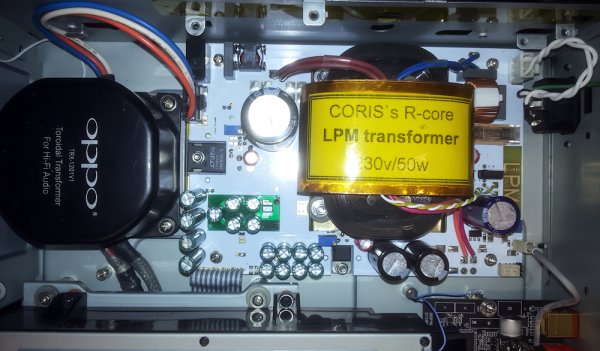- Replacing the original SMPS with the linear power module (internal mounted). This mod it include:
Double AC filters for internal transformer as for the original toroid (analogue power).
R core transformer for best main AC noise isolation.
Most advanced power regulators on market today for the best noise figures (output ripple & harmonics level under 3µV, at full load - 5A on 5v rail).
Remote current sensing design for best regulation at the cable connection endpoint
Extra HF filtering cell on cable connection end.
Solid filtering capacity values for both power rails (more than 100 000µF on 5v rail).
When implementing the internal LPM, it is recommended removing the multi-channel board for best cooling and ventilation of the entire device, including main processor.
This LPM it can work enough well with multi-channel board in place and functional, but then the inside ventilation is less effective and the overall working temperature it increase...
The LPM is now upgraded for a total of 400mF filtering capacity for 5v rail and 160mF for 15v rail. Rock stable on a large AC main variation, and superbe noise performances...
- Improving completely the original analogue power stage on stereo board, as the filtering caps on main/digital board - DC/DC converters/PSUs). This mod it include:
Schottky all rectifier diodes, solid filtering capacities, improving the existing +/- 12v regulators.
Adding pre regulator for 5v analogue power rail, replacing all of the stock regulators for DAC chip, with ultra-low noise ones.
Improving the existing regulator for DAC`s analogue stage, improving filtering capacities for all DAC power rails.
As an alternative, installing my special designed DAC PSU for the analogue power rails of the DAC chip,
and dismissing the original regulator on board.
- Implementing the output module. This mod it have two versions (active / passive) and it include:
1. Fully differential signal processing design (based on OPA1632), using dedicated ultra-low noise regulators (TPS) for each opamp chip.
Configuring DAC chip for 2+2 output. Special AC coupling caps configuration, for best signal transparency.
The output module is designed as a detachable approach, which it allow the user to experiment with different output circuits versions, without modifying any further on the stereo board.
A motherboard for this module, it is soldered on the stereo board, and it give access to the DAC output signals, to the +/-power lines, and to the AC coupled final outputs.
2. Lundahl transformers as passive output stage/module. This it mean the transformers are directly connected to the DAC chip.
No any active I/V stage, no AC coupling caps on outputs, not necessary the improvement of the analogue +/- power system, lower heat dissipation.
- Implementing the battery powered clock board. This mod it have two versions and it include:
Centralised powered clock system for the whole device. Damping mechanical mounting for clock board, to prevent any vibrations/alteration of the clock signals.
1. Epson SAW 108Mhz clock for DAC, 27Mhz and 20Mhz Abracon oscillators for main processor, and for HDMI chip, as a standard option.
2. Unified clock oscillator (SAW 216Mhz) for DAC and main processor, with high quality frequency divider (Ghz rated class device) + 20Mhz Abracon oscillator for HDMI chip.
- Improvements for the asynchronous USB interface. This mod include:
Isolated digital interface for the USB board (board fully electrical isolated from the rest of the player, including grounding).
Ultra low noise regulator replacing the original one on board. Entire board powered from its own low noise linear PSU. Replacing of the stock on board oscillators with NDK ones.
Double AC filters for internal transformer as for the original toroid (analogue power).
R core transformer for best main AC noise isolation.
Most advanced power regulators on market today for the best noise figures (output ripple & harmonics level under 3µV, at full load - 5A on 5v rail).
Remote current sensing design for best regulation at the cable connection endpoint
Extra HF filtering cell on cable connection end.
Solid filtering capacity values for both power rails (more than 100 000µF on 5v rail).
When implementing the internal LPM, it is recommended removing the multi-channel board for best cooling and ventilation of the entire device, including main processor.
This LPM it can work enough well with multi-channel board in place and functional, but then the inside ventilation is less effective and the overall working temperature it increase...
The LPM is now upgraded for a total of 400mF filtering capacity for 5v rail and 160mF for 15v rail. Rock stable on a large AC main variation, and superbe noise performances...
- Improving completely the original analogue power stage on stereo board, as the filtering caps on main/digital board - DC/DC converters/PSUs). This mod it include:
Schottky all rectifier diodes, solid filtering capacities, improving the existing +/- 12v regulators.
Adding pre regulator for 5v analogue power rail, replacing all of the stock regulators for DAC chip, with ultra-low noise ones.
Improving the existing regulator for DAC`s analogue stage, improving filtering capacities for all DAC power rails.
As an alternative, installing my special designed DAC PSU for the analogue power rails of the DAC chip,
and dismissing the original regulator on board.
- Implementing the output module. This mod it have two versions (active / passive) and it include:
1. Fully differential signal processing design (based on OPA1632), using dedicated ultra-low noise regulators (TPS) for each opamp chip.
Configuring DAC chip for 2+2 output. Special AC coupling caps configuration, for best signal transparency.
The output module is designed as a detachable approach, which it allow the user to experiment with different output circuits versions, without modifying any further on the stereo board.
A motherboard for this module, it is soldered on the stereo board, and it give access to the DAC output signals, to the +/-power lines, and to the AC coupled final outputs.
2. Lundahl transformers as passive output stage/module. This it mean the transformers are directly connected to the DAC chip.
No any active I/V stage, no AC coupling caps on outputs, not necessary the improvement of the analogue +/- power system, lower heat dissipation.
- Implementing the battery powered clock board. This mod it have two versions and it include:
Centralised powered clock system for the whole device. Damping mechanical mounting for clock board, to prevent any vibrations/alteration of the clock signals.
1. Epson SAW 108Mhz clock for DAC, 27Mhz and 20Mhz Abracon oscillators for main processor, and for HDMI chip, as a standard option.
2. Unified clock oscillator (SAW 216Mhz) for DAC and main processor, with high quality frequency divider (Ghz rated class device) + 20Mhz Abracon oscillator for HDMI chip.
- Improvements for the asynchronous USB interface. This mod include:
Isolated digital interface for the USB board (board fully electrical isolated from the rest of the player, including grounding).
Ultra low noise regulator replacing the original one on board. Entire board powered from its own low noise linear PSU. Replacing of the stock on board oscillators with NDK ones.
Attachments
Last edited:


